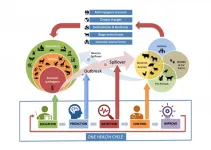(Press-News.org) Researchers at the University of North Carolina at Chapel Hill and Duke University improved HIV care by gamifying it with a mobile gaming application.
Gaming features - like those used to drive airline loyalty and track daily steps --- helped young men living with HIV achieve viral suppression and doubled their chances for reaching near perfect adherence to medication plans, according to a study in AIDS and Behavior.
Gamification can inspire changes in behavior when a doctor's advice or a patient's good intentions are not enough. In this case, motivating those living with HIV to stick to the antiretroviral therapy (ART) that can keep them healthy by suppressing the HIV virus.
Study authors include Lisa Hightow-Weidman and Kate Muessig, health behavior specialists at the UNC Gillings School of Global Public Health, Alyssa Vecchio of the UNC Institute for Global Health and Infectious Diseases, and Alyssa Platt and Joseph R. Egger of the Duke Global Health Institute.
"The app delivered daily health messages in a digestible form that was more fun than sitting in a class and more consistent than a clinic visit scheduled every three to six months," said lead study author Hightow-Weidman, professor of medicine and health behavior and mHealth researcher who directs the UNC Behavior and Technology Lab in the UNC School of Medicine.
Gamifying health promotion
Researchers teamed up with the web application development company Caktus Group to create a mobile phone app that could help patients to better adhere to HIV medication plans.
Specifically, the app was designed with the goal of improving medication adherence among young men who have sex with men who are living with HIV. It's the population most affected by HIV in the United States.
The app made use of game mechanics and social networking features to improve adherence to HIV medications. In addition to medication reminders and adherence tracking, Epic Allies used gaming elements to create a compelling and engaging experience that could motivate and support behavior change.
Gamers were awarded points and badges for their own successes and providing support and encouragement to others.
Rates of viral suppression and ART adherence increased over the course of the study among its 146 participants, even among those who were randomized to receive the control app -- weekly text-based information about adherence.
At 26 weeks, viral suppression among app users was 62.9% while viral suppression in the control group was 73.5%. When use of the Epic Allies app, which is no longer available, ended, viral suppression leveled out to about 64% for all study participants, who were ages 16-24.
Notably, the app appeared to provide a head start to controlling the HIV virus. Participants who used the app regularly - four or more days a week - had a reported 56% higher likelihood of achieving viral suppression at 13 weeks compared to those who didn't use the app. Regular app users were more than twice as likely to report near perfect ART adherence at both 13 weeks and 26 weeks compared to non-app users.
Digital bridges to care
Study limitations include the small sample size and authors write that issues with app use metrics limit the ability to say that the app was effective in causing behavior changes that improved health.
But Hightow-Weidman said technology is emerging to support high-risk patients who may have life circumstances - homelessness, mental health issues, substance abuse issues - that may make it harder for them to focus on the long term. For young people, it can be especially difficult to connect today's decisions to future health, she said.
And as telehealth and virtual visits gained momentum during COVID-19 shutdowns, lessons were learned about providing needed care for everyone.
"Apps and digital tools are a bridge to care," she said. "They cannot replace a network of doctors and nurses and care management, but they can be a bridge to that real world and inspire change."
The project was supported by a grant from the National Institutes of Health.
INFORMATION:
Research funding agencies around the world are testing creative approaches to address urgent needs while laying the foundation for discoveries that will meet the unpredictable demands of the future. According to a new expert panel report from the Council of Canadian Academies (CCA), Canada can bolster its research capacity by reducing administrative burdens, experimenting with funding approaches, and cultivating a robust, resilient, and diverse scientific workforce.
"In the past year we have seen the power and promise of transformative research and the ability of researchers and funding organizations to pivot in times of crisis," said Shirley M. Tilghman, PhD, O.C., FRS, Chair of the Expert Panel. "But the pandemic has also exacerbated existing inequalities ...
Almost half of the parents who have children together with a parent with schizophrenia or bipolar disorder, are themselves burdened by psychological issues. This can affect family life and the children. This is shown in the research result from the major Danish psychiatry project iPSYCH.
We typically choose a partner who resembles us in relation to social status, education and, to some extent, also income. Research has previously established this. A new study now shows that almost half of the parents who have children with a partner who suffers from schizophrenia or bipolar disorder themselves meet the criteria for a mental disorder. By comparison, this is 18 percent for parents in the control group.
The results stem from The Danish High-Risk and Resilience ...
Aging is the biggest risk factor for perturbation of the nervous system, even in the absence of distinct disease or trauma. For yet unknown reasons, the impulse conducting, myelinated projections and synaptic connections between nerve cells are especially vulnerable to aging-related degeneration. These pathological alterations often manifest as cognitive, sensory, and motor decline in older adults and represent a serious socio-economic challenge.
Malactivation leads to damage
Scientists have long assumed that inflammation plays an important role in this process. Mal- or overactivation of distinct cells belonging to the innate immune system - the microglia - appears to promote damage of nerve fibers and synapses ...
As the digital revolution has now become mainstream, quantum computing and quantum communication are rising in the consciousness of the field. The enhanced measurement technologies enabled by quantum phenomena, and the possibility of scientific progress using new methods, are of particular interest to researchers around the world.
Recently two researchers at Tampere University, Assistant Professor Robert Fickler and Doctoral Researcher Markus Hiekkamäki, demonstrated that two-photon interference can be controlled in a near-perfect way using ...
For the first time, international experts in psychology have built a framework to diagnose Compulsive Buying-Shopping Disorder - promising help for people struggling to manage their spending behaviour and mental wellbeing.
The new guidelines, published in the Journal of Behavioral Addictions, confirms that excessive buying and shopping can be so serious as to constitute a disorder, giving researchers and clinicians new powers to develop more targeted interventions for this debilitating condition.
The international collaboration, led by Professor Mike Kyrios from Flinders University's Órama Institute for Mental ...
SINGAPORE - A team of researchers from the Agency for Science, Technology and Research's (A*STAR) Genome Institute of Singapore (GIS) and Bioprocessing Technology Institute (BTI), as well as Singapore Eye Research Institute (SERI), have identified a genetic mutation (functionally defective CYP39A1 gene) associated with exfoliation syndrome, the most common cause of glaucoma. The findings could pave the way for future research on the cause of exfoliation syndrome and potential cures. Their research was published in Journal of the American Medical Association (JAMA) on 24 February 2021.
Exfoliation syndrome is a systemic ...
Artificial intelligence that enhances remote monitoring of water bodies - highlighting quality shifts due to climate change or pollution - has been developed by researchers at the University of Stirling.
A new algorithm - known as the 'meta-learning' method - analyses data directly from satellite sensors, making it easier for coastal zone, environmental and industry managers to monitor issues such as harmful algal blooms (HABs) and possible toxicity in shellfish and finfish.
Environmental protection agencies and industry bodies currently monitor the 'trophic state' of water - its biological productivity - as an indicator of ecosystem health. Large clusters of microscopic algae, or phytoplankton, is called eutrophication and can ...
Mangroves and seagrasses grow in many places along the coasts of the world, and these 'blue forests' constitute an important environment for a large number of animals. Here, juvenile fish can hide until they are big enough to take care of themselves; crabs and mussels live on the bottom; and birds come to feed on the plants.
However, the plant-covered coastal zones do not only attract animals but also microplastics, a new study shows.
- The denser the vegetation, the more plastic is captured, says Professor and expert in coastal ecology, Marianne Holmer, from the University of Southern Denmark.
She is concerned about how the accumulated microplastics affect animal and plant life.
- We know from other ...
The EU-funded BIO-CRIME project - with support from the Leibniz Institute for Zoo and Wildlife Research (Leibniz-IZW) - conducted a scientific investigation on the topic of illegal small animal trade and the associated risk of pathogen transmission.
The study focused on the key areas of "illegal small animal trade" and the level of knowledge and proper behaviours of young people and adolescents with "zoonotic diseases" and the "One Health concept". One Health is an approach that recognises that human health is closely linked to the health of animals and our shared ...
In 2019 the climate movement experienced an unprecedented growth in its mobilization capacity and its political and media impact. The success of the movement is closely linked to the figure of Greta Thunberg and the global impact of her discourse and the "Fridays for Future" movement in hundreds of cities around the world.
A study by Silvia Díaz-Pérez, Roger Soler-i-Martí and Mariona Ferrer-Fons, members of the UPF JOVIS research group of the Department of Communication, analyses the activist's speeches and messages on social networks and their legitimization through her personal story, and it also looks into the "Fridays for Future" movement in Barcelona, based on Twitter and Instagram posts. The research was based on a project that has received funding from ...








